|
|
| Province and Destinations |
|
| Bari (5m s./m.) |
 Bari, is the Apulian capital and has been characterised for centuries by intense commercial activity. It was probably founded in 150 B.C. in the territory of the Peucezi, an ancient population of the japigio line.
Bari, is the Apulian capital and has been characterised for centuries by intense commercial activity. It was probably founded in 150 B.C. in the territory of the Peucezi, an ancient population of the japigio line.
|
| Alberobello (428m s./m.) |
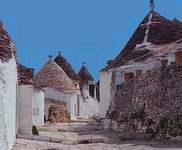 In the heart of Murge, the central highland in Puglia, surrounded by olive and vineyards, this picturesque country town is famous for being almost entirely made up of "trulli" that are a national heritage.
In the heart of Murge, the central highland in Puglia, surrounded by olive and vineyards, this picturesque country town is famous for being almost entirely made up of "trulli" that are a national heritage.
|
| Bisceglie (16m s./m.) |
 The city of Bisceglie is located in a beautiful bay along the Adriatic shoreline, at the feet of the Coastal Murgia and it is appreciated for the beautiful sea with its most searched beaches, the tasty agricultural and fishing products.
The city of Bisceglie is located in a beautiful bay along the Adriatic shoreline, at the feet of the Coastal Murgia and it is appreciated for the beautiful sea with its most searched beaches, the tasty agricultural and fishing products. |
| Corato (232m s./m.) |
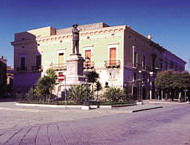 The graceful city of Corato rises in the territory of the Murgia, between the Adriatic coast and the evocative village of Castel del Monte, the main attractions in the northern area of Bari.
The graceful city of Corato rises in the territory of the Murgia, between the Adriatic coast and the evocative village of Castel del Monte, the main attractions in the northern area of Bari. |
| Brindisi (15m s./m.) |
 It was once inhabited by Messapi, is set halfway between the ancient “Apulia” and “Calabria” synthetizing their two “souls”: the jovial people and their traditions - customs and in the folk feasts amid a pretty landscape.
It was once inhabited by Messapi, is set halfway between the ancient “Apulia” and “Calabria” synthetizing their two “souls”: the jovial people and their traditions - customs and in the folk feasts amid a pretty landscape.
|
| Ostuni (207m s./m.) |
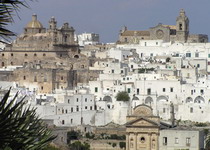 The white city of Ostuni rises on three hills at 8 km from the coast of the Salento in the province of Brindisi, an important tourist and agricultural center (olive groves and vineyards) that it counts numerous "masserie", the ancient fortified farms.
The white city of Ostuni rises on three hills at 8 km from the coast of the Salento in the province of Brindisi, an important tourist and agricultural center (olive groves and vineyards) that it counts numerous "masserie", the ancient fortified farms. |
| Torre Canne di Fasano (118m s./m.) |
 We are in the extreme part of Murge's higlands, along the coast between Brindisi and Ostuni. Picturesque ports alternate with many summer resorts, towns with an illustrious past and olive groves.
We are in the extreme part of Murge's higlands, along the coast between Brindisi and Ostuni. Picturesque ports alternate with many summer resorts, towns with an illustrious past and olive groves.
|
| Foggia (72m s./m.) |
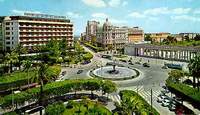 The city of Foggia is located in the plains of the "Tavoliere delle Puglie" and it is one of the main agricolture and commercial center as the main rail and motorway junction in Apulia.
The city of Foggia is located in the plains of the "Tavoliere delle Puglie" and it is one of the main agricolture and commercial center as the main rail and motorway junction in Apulia.
|
| Monte Sant'Angelo (796m s./m.) |
 The village of Monte Sant'Angelo is part of the Gargano National Park, in the north of the Foggia province and it has an agricultural economy and a tourist development for the pilgrimages to the church of San Michele Archangel.
The village of Monte Sant'Angelo is part of the Gargano National Park, in the north of the Foggia province and it has an agricultural economy and a tourist development for the pilgrimages to the church of San Michele Archangel. |
| Rodi Garganico (5m s./m.) |
 The white town of Rodi Garganico is a famous bathing resort lying down from a hill to the blue sea amid its sweet perfumed orange lemon plantations and secular olive-trees.
The white town of Rodi Garganico is a famous bathing resort lying down from a hill to the blue sea amid its sweet perfumed orange lemon plantations and secular olive-trees.
|
| San Giovanni Rotondo (556m s./m.) |
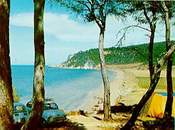 San Giovanni Rotondo is a gate to the promontory of Gargano, also called “Italy’s Spur”. The extraordinary beauty of the landscape and of the shores accounts for the recent tourist boom of the promontory.
San Giovanni Rotondo is a gate to the promontory of Gargano, also called “Italy’s Spur”. The extraordinary beauty of the landscape and of the shores accounts for the recent tourist boom of the promontory.
|
| San Menaio, Vico del Gargano (3m s./m.) |
 San Menaio is a pleasant village located in the municipality of Vico del Gargano in northern Apulia between orange-orchads and pine-wood-parks boastings a pretty sandy beach, a beautiful and trasparent sea set amid a luxuriant Mediterranean vegetation lush.
San Menaio is a pleasant village located in the municipality of Vico del Gargano in northern Apulia between orange-orchads and pine-wood-parks boastings a pretty sandy beach, a beautiful and trasparent sea set amid a luxuriant Mediterranean vegetation lush.
|
| Lecce (49m s./m.) |
 Located at the center of the Salento's Peninsula and is one of Apulia's most important cities, with a notable artistic heritage for the importance of the "barocco" and is considered as 'Florence of the Apulia'.
Located at the center of the Salento's Peninsula and is one of Apulia's most important cities, with a notable artistic heritage for the importance of the "barocco" and is considered as 'Florence of the Apulia'.
|
| Gallipoli (3m s./m.) |
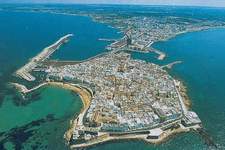 Gallipoli is located on the west side of the Ionian Sea, in front of the Taranto Gulf.
The suggestive old city, with the Antique buildings and murals, built in a Calcareous Island connected to the mainland with a brick bridge.
Gallipoli is located on the west side of the Ionian Sea, in front of the Taranto Gulf.
The suggestive old city, with the Antique buildings and murals, built in a Calcareous Island connected to the mainland with a brick bridge.
|
| Otranto (3m s./m.) |
 Otranto, called the door of the East, quickly strikes with his renaissance strengthened castle but the historical center, inside the strengthened city walls , has nowadays, a peaceful tourist invasion.
Otranto, called the door of the East, quickly strikes with his renaissance strengthened castle but the historical center, inside the strengthened city walls , has nowadays, a peaceful tourist invasion.
|
| Santa Maria di Leuca (3m s./m.) |
 Leuca is certainly one of the most inviting area of the Salento, renommed for its "Cape" that geografically divides the Adria from the Jonio Sea and also for the frequent pilgrimage to its historic sanctuary.
Leuca is certainly one of the most inviting area of the Salento, renommed for its "Cape" that geografically divides the Adria from the Jonio Sea and also for the frequent pilgrimage to its historic sanctuary.
|
|
|

 Bari, is the Apulian capital and has been characterised for centuries by intense commercial activity. It was probably founded in 150 B.C. in the territory of the Peucezi, an ancient population of the japigio line.
Bari, is the Apulian capital and has been characterised for centuries by intense commercial activity. It was probably founded in 150 B.C. in the territory of the Peucezi, an ancient population of the japigio line.  In the heart of Murge, the central highland in Puglia, surrounded by olive and vineyards, this picturesque country town is famous for being almost entirely made up of "trulli" that are a national heritage.
In the heart of Murge, the central highland in Puglia, surrounded by olive and vineyards, this picturesque country town is famous for being almost entirely made up of "trulli" that are a national heritage. The city of Bisceglie is located in a beautiful bay along the Adriatic shoreline, at the feet of the Coastal Murgia and it is appreciated for the beautiful sea with its most searched beaches, the tasty agricultural and fishing products.
The city of Bisceglie is located in a beautiful bay along the Adriatic shoreline, at the feet of the Coastal Murgia and it is appreciated for the beautiful sea with its most searched beaches, the tasty agricultural and fishing products. The graceful city of Corato rises in the territory of the Murgia, between the Adriatic coast and the evocative village of Castel del Monte, the main attractions in the northern area of Bari.
The graceful city of Corato rises in the territory of the Murgia, between the Adriatic coast and the evocative village of Castel del Monte, the main attractions in the northern area of Bari. It was once inhabited by Messapi, is set halfway between the ancient “Apulia” and “Calabria” synthetizing their two “souls”: the jovial people and their traditions - customs and in the folk feasts amid a pretty landscape.
It was once inhabited by Messapi, is set halfway between the ancient “Apulia” and “Calabria” synthetizing their two “souls”: the jovial people and their traditions - customs and in the folk feasts amid a pretty landscape.  The white city of Ostuni rises on three hills at 8 km from the coast of the Salento in the province of Brindisi, an important tourist and agricultural center (olive groves and vineyards) that it counts numerous "masserie", the ancient fortified farms.
The white city of Ostuni rises on three hills at 8 km from the coast of the Salento in the province of Brindisi, an important tourist and agricultural center (olive groves and vineyards) that it counts numerous "masserie", the ancient fortified farms. We are in the extreme part of Murge's higlands, along the coast between Brindisi and Ostuni. Picturesque ports alternate with many summer resorts, towns with an illustrious past and olive groves.
We are in the extreme part of Murge's higlands, along the coast between Brindisi and Ostuni. Picturesque ports alternate with many summer resorts, towns with an illustrious past and olive groves.  The city of Foggia is located in the plains of the "Tavoliere delle Puglie" and it is one of the main agricolture and commercial center as the main rail and motorway junction in Apulia.
The city of Foggia is located in the plains of the "Tavoliere delle Puglie" and it is one of the main agricolture and commercial center as the main rail and motorway junction in Apulia. 
 The village of Monte Sant'Angelo is part of the Gargano National Park, in the north of the Foggia province and it has an agricultural economy and a tourist development for the pilgrimages to the church of San Michele Archangel.
The village of Monte Sant'Angelo is part of the Gargano National Park, in the north of the Foggia province and it has an agricultural economy and a tourist development for the pilgrimages to the church of San Michele Archangel. The white town of Rodi Garganico is a famous bathing resort lying down from a hill to the blue sea amid its sweet perfumed orange lemon plantations and secular olive-trees.
The white town of Rodi Garganico is a famous bathing resort lying down from a hill to the blue sea amid its sweet perfumed orange lemon plantations and secular olive-trees.  San Giovanni Rotondo is a gate to the promontory of Gargano, also called “Italy’s Spur”. The extraordinary beauty of the landscape and of the shores accounts for the recent tourist boom of the promontory.
San Giovanni Rotondo is a gate to the promontory of Gargano, also called “Italy’s Spur”. The extraordinary beauty of the landscape and of the shores accounts for the recent tourist boom of the promontory.  San Menaio is a pleasant village located in the municipality of Vico del Gargano in northern Apulia between orange-orchads and pine-wood-parks boastings a pretty sandy beach, a beautiful and trasparent sea set amid a luxuriant Mediterranean vegetation lush.
San Menaio is a pleasant village located in the municipality of Vico del Gargano in northern Apulia between orange-orchads and pine-wood-parks boastings a pretty sandy beach, a beautiful and trasparent sea set amid a luxuriant Mediterranean vegetation lush. Located at the center of the Salento's Peninsula and is one of Apulia's most important cities, with a notable artistic heritage for the importance of the "barocco" and is considered as 'Florence of the Apulia'.
Located at the center of the Salento's Peninsula and is one of Apulia's most important cities, with a notable artistic heritage for the importance of the "barocco" and is considered as 'Florence of the Apulia'.  Gallipoli is located on the west side of the Ionian Sea, in front of the Taranto Gulf.
The suggestive old city, with the Antique buildings and murals, built in a Calcareous Island connected to the mainland with a brick bridge.
Gallipoli is located on the west side of the Ionian Sea, in front of the Taranto Gulf.
The suggestive old city, with the Antique buildings and murals, built in a Calcareous Island connected to the mainland with a brick bridge.  Otranto, called the door of the East, quickly strikes with his renaissance strengthened castle but the historical center, inside the strengthened city walls , has nowadays, a peaceful tourist invasion.
Otranto, called the door of the East, quickly strikes with his renaissance strengthened castle but the historical center, inside the strengthened city walls , has nowadays, a peaceful tourist invasion. Leuca is certainly one of the most inviting area of the Salento, renommed for its "Cape" that geografically divides the Adria from the Jonio Sea and also for the frequent pilgrimage to its historic sanctuary.
Leuca is certainly one of the most inviting area of the Salento, renommed for its "Cape" that geografically divides the Adria from the Jonio Sea and also for the frequent pilgrimage to its historic sanctuary.